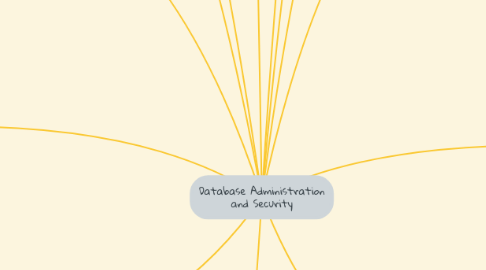
1. Data
1.1. Dirty data
1.1.1. Data that suffer from inaccuracies and inconsistencies
1.2. Data quality
1.2.1. Ensuring accuracy, validity, and timeliness of data
1.3. Data profiling software
1.3.1. Determine data patterns and compare them against standards defined by the organization
1.4. Master data management (MDM) software
1.4.1. Helps prevent dirty data by coordinating across multiple systems
2. Evolution of the Database Administration Function
2.1. Information systems (IS) department
2.1.1. Provides end users with data management support and solutions for information needs
2.2. Database administrator
2.2.1. Responsible for control of the centralized and shared database
2.3. Systems administrator
2.3.1. General coordinator of all DBAs
2.4. Data administrator (DA) or information resource manager (IRM)
2.4.1. Has a higher degree of responsibility and authority than the DBA
3. DBA’s Managerial Role
3.1. Provide end-user support
3.2. Enforce policies, procedures, and standards for correct data creation, usage, and distribution within the database
3.3. Manage data security, privacy, and integrity
3.4. Manage data backup and recovery -Fully recover data in case of data loss - Database security officer (DSO): Ensures database security and integrity
4. DBA’s Technical Role
4.1. Evaluate, select, and install DBMS and related utilities
4.2. Design and implement databases and applications
4.3. Test and evaluate databases and applications
4.4. Operate the DBMS, utilities, and applications
4.5. Train and support users
4.6. Maintain the DBMS, utilities, and applications
5. Security Goals
5.1. Confidentiality: Protecting data against unauthorized access
5.2. Compliance: Activities that meet data privacy and security reporting guidelines
5.3. Integrity: Keeping data consistent and free of errors or anomalies
5.4. Availability: Accessibility of data whenever required by authorized users and for authorized purposes
6. Security Vulnerability
6.1. Weakness in a system component that could allow unauthorized access or cause service disruptions
6.2. Categories - Technical, managerial, cultural, and procedural
6.3. Security threat: Imminent security violation
6.4. Security breach: Occurs when a security threat is exploited and could lead to a database whose integrity is preserved or corrupted
7. Data Dictionary
7.1. Types
7.1.1. ntegrated - Included with the DBMS
7.1.2. Standalone - Third-party systems
7.2. Active data dictionary: Automatically updated by the DBMS with every database access
7.3. Passive data dictionary: Requires running a batch process
7.4. Main function - Store description of all objects that interact with the database
8. Special Considerations
8.1. Technological aspect
8.1.1. Selecting, installing, configuring, and monitoring the DBMS to ensure that it operates efficiently
8.2. Managerial aspect
8.2.1. Careful planning to create an appropriate organizational structure
8.3. Cultural aspect
8.3.1. Listening to people’s concerns about the system and explaining its uses and benefits
9. DBA’s Role in the Cloud
9.1. Reduced role in installing and maintaining the DBMS as cloud services provide:
9.1.1. DBMS installation and updates
9.1.2. Server/network management
9.1.3. Backup and recovery operations
10. Security Policy
10.1. Collection of standards, policies, and procedures created to guarantee security
10.1.1. Ensures auditing and compliance
10.2. Security audit process
10.2.1. Identifies security vulnerabilities
10.2.2. Identifies measures to protect the system
11. Database Security
11.1. Authorization management: Procedures to protect database security and integrity
11.1.1. User access management
11.1.2. View definition
11.1.3. DBMS access control
11.1.4. DBMS usage monitoring
12. Components of a CASE Tool
12.1. Graphics
12.2. Screen painters and report generators
12.3. Integrated repository
12.4. Analysis segment
12.5. Program documentation generator
13. Types of Tablespace
13.1. SYSTEM
13.1.1. Stores the data dictionary data
13.2. USERS
13.2.1. Stores the table data created by the end users
13.3. TEMP
13.3.1. Stores the temporary tables and indexes created during the execution of SQL statements
13.4. UNDOTBS1
13.4.1. Stores database transaction recovery information

